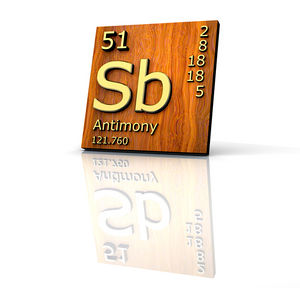Antimony
From Health Facts
Latest Edit: Hector 2014-02-13 (EDT)
Antimony is a heavy metal with similar toxic affects to Arsenic. The most common form of antimony responsible for human exposure is stibine (antimony hydride), a toxic gas.
Contents
Background
- Antimony is used in industry in metal alloys, as a lead hardening agent, and in glass manufacturing.
- The major source of exposure to antimony occurs occupationally.
- Antimony is fully absorbed through the lungs upon inhalation, but is less absorbable in the gastrointestinal system upon ingestion.
- Concentration of antimony occurs in the heart, liver, thyroid, and on red blood cells. When absorbed, antimony can bind to numerous enzymes in the body and can cause vomiting, diarrhea, abdominal pain, cardiovascular disturbance, and liver damage.[1]
Associated Conditions
Conditions associated with exposure to antimony include:[2]
- Pulmonary Edema
- Pneumoconiosis
- Chronic Bronchitis
- COPD
- Spontaneous abortion
- Menstrual Irregularities
Symptoms
Common symptoms of antimony toxicity include:[1]
- Epistaxis
- Nausea and Vomiting
- Pulmonary Edema
- Diarrhea
- Abdominal Pain
Sources
- Bottled water in Canada, Europe, and the United States has been shown to leach antimony from polyethylene terephthalate (PET) plastics. This process is accelerated when bottles are exposed to higher temperatures.[3]
- Polyethylene terephthalate plastic is also used in microwaveable meals. Studies have demonstrated an increase in antimony levels post-microwaving, but levels remain under the accepted tolerable daily intake.[4]
- Industry
- Antimony oxides have been used in flame retardents on textiles, and on fabrics. [5]
- Pharmaceuticals
- Antimony has been used in antihelminthic drugs in the treatment of schistosomiasis. Side effects of these medications include myocarditis, pericardial effusion, and other electrocardiographic abnormalities. Rarely these adverse effects can be as serious as bradycardia, ventricular arrhythmias, and sudden death.[6]
- As a component of brake pad systems, antimony can become airoborne and absorbed. Studies have demonstrated elevated blood antimony levels in workers exposed to high levels of heavy traffic.[7]
Diagnostic Testing
- Urinary Testing
- Urinary testing may be used to measure antimony levels. [1]
- Blood Chemistry
- Blood levels of antimony can be measured to confirm diagnosis of antimony toxicity.[1]
Treatment
Symptomatic and supportive treatment is most commonly used in antimony toxicity.
- Other Therapies
- In the case of acute stibine exposure, supportive care and exchange infusion are primary treatment strategies.[1]
References
- ↑ 1.0 1.1 1.2 1.3 1.4 1.5 Hall AH, Shannon MW (2007) Shannon: Haddad and Winchester’s Clinical Management of Poisoning and Drug Overdose 4th ed Chap 75 Other Heavy Metals Saunders
- ↑ Agency for Toxic Substances and Disease Registry (ATSDR) (1992) Toxicological Profile for Antimony US Public Health Service, US Department of Health and Human Services, Atlanta GA
- ↑ Westerhoff P (2008) Antimony leaching from polyethylene terephthalate (PET) plastic used for bottled drinking water Water Res 42(3):551-6
- ↑ Haldimann (2007) Exposure to antimony from polyethylene terephthalate (PET) trays used in ready to eat meals Food Addit Contam 24(8):860-8
- ↑ Centres for Disease Control Pseudo-outbreak of antimony toxicity in firefighters- Florida 2009 MMWR Morb Mortal Wkly Rep 2009 58(46):1300-2
- ↑ Lange RA, Hillis LD (2011) Bonow: Braunwald’s Heart Disease- A Textbook of Cardiovascular Medicine 9th ed Chap 73 Toxins and the Heart Saunders
- ↑ Quiroz W (2009) Heavy weight vehicle traffic and its relationship with antimony content in human blood J Environ Monit 11(5):1051-5
